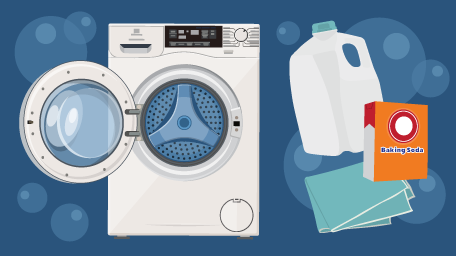Enter the code USA15 at checkout to apply your discount. Discount will be applied at checkout when the code is entered & applies to all parts. Cannot be combined with any other coupon or special offer & cannot be applied to a previously placed order. Not valid toward tax or shipping & handling. Discount has no cash value. Discount expires on July 1 at 11:59pm EST.

How to Load Your Dishwasher
A properly loaded dishwasher will clean your dishes more effectively and eliminate the need to wash any items by hand. But did you know that many people will go their whole lives without ever knowing the proper rules and methods for effectively loading their dishwasher for best results? Not only can improper loading cause issues with getting your dishes properly cleaned, it can also cause damage to your machine and the dishes you load. In our experience, many people who report a broken or malfunctioning dishwasher are often just not using their dishwasher correctly, leading to negative symptoms. With our tips and tricks, you’ll learn how to make sure your dishes come out clean and shiny every time which can save you time AND money!

While all dishwashers are basically the same, some manufacturers have different advice for how to load the racks. Make sure to first consult the user manual or owner's guide for your model and follow their instructions.
Bottom Rack
With most dishwashers, the larger items go on the lower rack. These items include plates, large bowls, cutting boards, casserole dishes etc. The key to making sure everything gets cleaned properly is to make sure there is enough space between the items so that water can freely circulate.
You also need to make sure that items don’t protrude below the wire rack as they could interfere with your sprayer or become damaged.

Try not to put plastic items on the bottom rack. Plastic items are more sensitive to the heat from the heating element and could melt.
Make sure to check the edges of your dishes, if any are chipped or have sharp edges, be careful when putting them on the rack so you don’t cause damage to your rack, which could lead to a rust problem.

Cutlery Basket
Place items that are prone to nesting together – such as spoons – in different areas. You can also alternate your utensils handle down and handle up to keep them from nesting. If items like these stick together, they may not get cleaned on the front side of one or the backside of the other.

If you have sharp items such as knives or forks, avoid dropping them into your cutlery basket. Doing so could potentially damage the bottom of your basket and the sharp items could go down through the bottom of your basket and interfere with the bottom spray arm.

Upper Rack
Load glassware, smaller bowls and cutlery that may not fit properly on the bottom rack – such as large, sharp knives - onto the upper rack. You also may find that plastic bowls that don’t fit well on the bottom rack, will fit nicely on the upper rack. Keep in mind that if you place a large item over other items, the large item may not get a good wash.
Most upper racks are designed to let bowls fit down through the center. Typically, you’ll see the tines pointed in one direction towards the back of the dishwasher and the opposite direction towards the front – this lets you place bowls facing toward the center. When loading multiple bowls, make sure they have enough space between them to ensure they all get a good cleaning.

The rest of the rack is designed to handle mugs and glasses. Try to avoid placing glassware or mugs over the tines. If items rest or sit on tines, the tines may leave a stain on the bottom of your dish.
Most racks will have something designed for long stemware to keep items such as wine glasses from wobbling around and breaking. Make sure to place your stemware in the proper spot to avoid any damage.

Bonus Tips
To ensure your dishes come out sparkling, always use a good quality detergent – whether it’s a liquid or tablet – and always store your detergent in a cool dry place.
Periodically check the filters in your dishwasher to make sure they are clean and functioning properly.

Check your spray arms to make sure the holes aren’t plugged with any items. If any of the holes are plugged, you will need to clear them.

Finally, don’t wash your dishes before you wash your dishes. Scraping off any large food items should be sufficient. Dishwashing detergent is typically a harsh chemical and if there is no food soil to react to, it will react with your dishes and potentially cause serious damage.

Properly vs. Improperly Loaded Dishwasher: How Much Difference Does It Make?
We took two identical dishwashers to demonstrate what happens when you don’t properly load the dishwasher versus the outcome of a properly loaded dishwasher. For the properly loaded dishwasher we kept lots of space between the dishes and plated all the cutlery with the dirty end up. The same goes for the upper rack. We left lots of space and made sure not to block the sprayer arm. For the unproperly loaded dishwasher we put no effort into the organization of dishware. We just crammed everything in wherever we could fit it. We shoved all the cutlery possible into the cutlery basket without any effort.
Before we began our experiment, we made sure to purge the hot water line. This is an important step because typically your first fill will only use cold water that is in the water lines. Pick the closest faucet to your dishwasher (usually the kitchen sink), turn on the hot water until it is as hot as it will get, turn it off and start the dishwasher. We added detergent into the dispensers of both dishwashers and began our experiment!
Once both dishwashers completed their cycles, we checked for the results. The properly loaded dishwasher looked excellent. All the dishes were sparkly clean as you would expect. When we checked the improperly loaded dishwasher the results were not so great. Food was still caked on, as not leaving enough space between the dishes didn’t allow for the water to circulate properly and give us our desired results. Our experiment was a success – it DOES matter how you load your dishwasher! Check out the video below to see the results for yourself.

That's all there is to it! Follow these tips and basic principles of dishwasher loading, and you'll get a sparkling clean load of dishes every time, and get a much longer life out of your kitchenware and your dishwasher. Did you know that we carry a wide range of dishwasher parts. If you discover any parts in your dishwasher that need replacing, which may happen over time due to any of the above reasons, use your model number and browse what we have to see if we have the right part for your machine.






























